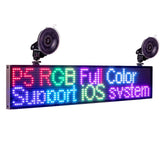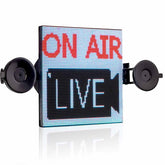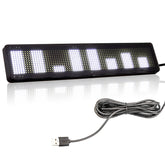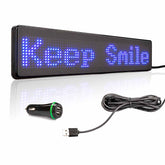Modbus TCP Communication Sign LED Display Solutions
The MODBUS protocol allows simple communication within a variety of network architectures. Every device (PLC, HMI, control panel, driver, motion control, input/output device) can use the MODBUS protocol to initiate remote operations.
Modbus has the following three communication modes:
Ethernet: The corresponding communication mode is Modbus TCP/IP
Asynchronous serial transmission (various media such as wired RS-232-/422/485/; Fiber, wireless, etc.): The corresponding communication mode is Modbus RTU or Modbus ASCII
High-speed token passing network: The corresponding communication mode is Modbus PLUS.

Modbus RTU Data frame structure
The instructions in the RTU protocol are composed of five parts: function code (one byte), starting address (two bytes), address code (one byte), data (N bytes), check code (two bytes), in which the data is composed of data length (two bytes, indicating the number of registers, assuming the content is M) and data body (M multiplied by two bytes).
Take 01 06 00 00 00 1F C8 02 for example
01 Address 01
06 Write Register
00 00 Register 0 corresponds to variable 0
00 1F The value 31 is displayed
C8 02 Modbus CRC verification code
Modbus TCP data frame structure
Modbus TCP adds the MBAP packet header to Modbus RTU. Since TCP is a service based on a reliable connection, there is no CRC check in Modbus TCP. All Modbus TCPADU sends and receive TCP transmission control protocols. The Modbus TCP/IP server usually uses port 502 as the port for receiving packets.
Take 00 01 00 00 00 06 01 06 00 00 00 00 00 1F for example
01 Address 01
06 Write Register
00 00 Register 0 corresponds to variable 0
00 1F The value 31 is displayed
Modbus TCP: The network protocol is not verified.
The modbus.ini file also supports text display by modifying the parameter configuration. The following is a description of the displayed text configuration parameters.
|
parameter name |
Type |
default |
describe |
|
MaxVarNo |
int |
1 |
The value ranges from 1 to 100 |
|
UnitType |
int |
1 |
Unit type: 0: Units are not displayed. 1: displays the original unit. 2: Display replacement units, currently only ug/m3 can be replaced, need to use the font file "symbol.lmf" |
|
Timeout |
int |
200 |
The Modbus protocol read timeout is expressed in milliseconds. The stable running of the current test cannot be less than 200ms |
|
Interval |
int |
5000 |
Total cycle interval, in milliseconds |
|
DispTypeNum |
int |
1 |
A maximum of 16 types can be displayed |
|
AreaNum |
int |
4 |
The value can be a maximum of 32 |
|
1 |
string |
0,1, leisure,0,255,0 |
Separated by commas, the first two are range values (close the interval, can be decimal), the third is the text to be displayed (not more than 32 bytes), if it is @@, it means that the original value is displayed, the following three are color RGB values, the whole line does not exceed 128 bytes |
|
[1] |
int |
|
Variable number |
|
DeviceAddr |
int |
1 |
Modbus device address |
|
DataAddr |
int |
0 |
Data register address |
|
DataLen |
int |
2 |
The value can be 1 or 2. 2 indicates that two values and four bytes are read at a time |
|
Signed |
int |
0 |
Unsigned, 0. Unsigned number, 1. Signed number, 2. The highest digit is the sign 1 minus 0 plus. |
|
Offset |
int |
0 |
Record the deviation between the data stored at the address and the actual value. The default value is 0, which takes precedence over the operator calculation |
|
Sobel |
int |
1 |
Operator, multiply the read data by this operator to obtain the data to be displayed. The default is 1 |
|
Unit |
string |
ug/m3 |
The unit to be displayed is valid when UnitType=1/2. The maximum length is 10 |
|
Format |
string |
%d |
Standard format string in the C language. The default is %d, and the maximum length is 10 |
|
FillSpaceNum |
int |
0 |
The number of Spaces that need to be filled between data and units when displayed. The default value is 0 |
|
ExistDecimal |
int |
1 |
Whether there is a decimal, 1 exists, 0 does not exist. The default value is 0 |
|
DispTypeNo |
int |
1 |
The current value displays the display type number corresponding to "DispTypeNum". The value is "1" to "DISPtypenum" |
|
Function |
int |
1 |
Variable function, 0. Display variable, 1. Select broadcast program, 2. Set brightness, default is 0 |
Download the Protocol
| C-power asynchronous controller | Download Protocol |
Contact us for customizing this Industrial LED sign with a Communication Protocol.






